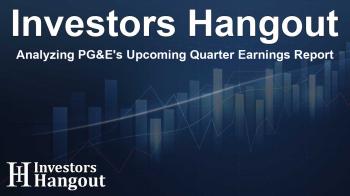Analyzing PG&E's Upcoming Quarter Earnings Report

Understanding PG&E's Earnings Outlook
PG&E (PCG) is nearing the release of its quarterly earnings report, which has investors on the edge of their seats. Anticipated on Thursday, this report is crucial for stakeholders looking to gauge the company’s financial health and future direction.
Projected Earnings Per Share Insights
Market analysts are predicting an earnings per share (EPS) of $0.32 for the upcoming quarter. This estimate reflects hopes that PG&E may exceed past performance and set a positive tone moving forward.
Investor Sentiment Ahead of the Release
In the lead-up to the earnings announcement, investor interest is high as many are looking for indications of the company's ability to outperform current expectations. Positive results might help improve confidence in PG&E's growth trajectory for the next quarterly report.
Reviewing Past Earnings Performance
During the last earnings release, PG&E fell short of EPS forecasts by $0.02. This led to a notable 1.44% decline in share value the following trading day. Such fluctuations emphasize the volatility present in stock prices influenced more by future outlooks than historical performances.
Previous Earnings Data Overview
Pacing Through Recent Earnings Records
Here's how PG&E's recent earnings have panned out, shedding light on market behavior:
- Q4 2024: Estimated EPS of 0.31, Actual EPS of 0.31, Price Change -4.0%
- Q3 2024: Estimated EPS of 0.33, Actual EPS of 0.37, Price Change +1.0%
- Q2 2024: Estimated EPS of 0.30, Actual EPS of 0.31, Price Change 0.0%
Analyzing the Current Share Price
PG&E shares were recorded at $13.99 recently, reflecting a decrease of 23.4% over the past year. Such trends might leave long-term investors feeling discontent as they approach this imminent earnings report.
Insights from Market Analysts on PG&E
Market Sentiment and Analyst Consensus
Understanding how analysts view PG&E can provide deeper insights for investors. Currently, PG&E holds a consensus rating of Outperform from three analysts, with an average one-year price target set at $19.67. This projection suggests a promising upside potential of 40.6%, indicating positive sentiment among market analysts.
Comparison with Industry Peers
Evaluating PG&E's Position Against Competitors
A broader market comparison allows for an understanding of PG&E's relative performance against other companies in the utility sector. For example, analysts rated NRG Energy with a Buy status and an impressive price target of $178.43, suggesting an upside of 1175.41%. Similarly, PPL is viewed favorably with a target price of $37.33 for a potential upside of 166.83%. Conversely, peers like Eversource Energy are anticipated to remain Neutral with a price target pointing towards a more modest upside.
Insights from Peer Analysis
Benchmarking Performance Standards
Key performance indicators reveal that PG&E is currently lagging in revenue growth compared to its peers:
- Revenue Growth: 2.08% - relatively weak in the sector
- Gross Profit: $2.44 billion, showing room for improvement
- Return on Equity (ROE): 2.10%, indicating challenges in capital utilization
Despite its standing, PG&E maintains a decent return on equity, indicating some level of effectiveness in providing returns to its shareholders even in a challenging environment.
Dissecting PG&E's Corporate Strategy
Key Recent Developments
Operating primarily through its subsidiary, Pacific Gas and Electric, PG&E has been a significant player serving over 5 million electricity customers across California. After weathering bankruptcy proceedings between January 2019 and June 2020, the firm aims to stabilize and regain investor confidence in its operational capacity.
Financial Position: A Closer Look
Assessing Market Capitalization and Revenue Trends
PG&E's market capitalization appears below industry standards, which reflects its long-standing challenges in growth perceptions. Recent financial data indicates a revenue growth rate of 2.08% as of March 31, 2025, marking a positive step but still trailing behind its industry competitors.
Triaging Financial Health Indicators
Evaluating Key Financial Metrics
Examination of PG&E's financial health highlights several critical factors:
- Net Margin: A net margin of 10.15% suggests struggles with profitability.
- Debt Management: A debt-to-equity ratio of 2.06 indicates the company's higher reliance on debt, amplifying financial risks.
Frequently Asked Questions
What is PG&E's anticipated EPS for the upcoming quarter?
PG&E is expected to report an earnings per share (EPS) of $0.32.
How has PG&E's stock performed in the last year?
The stock has decreased by 23.4% over the previous year.
What is the current average price target for PG&E by analysts?
The average one-year price target for PG&E is set at $19.67, suggesting a potential upside.
What challenges is PG&E facing in terms of profitability?
PG&E's net margin is below industry standards, indicating difficulties in achieving strong profitability.
How does PG&E compare with its industry peers?
PG&E ranks lower in revenue growth and gross profit compared to competitors like NRG Energy and PPL but shows a decent return on equity.
About The Author
Contact Dylan Bailey privately here. Or send an email with ATTN: Dylan Bailey as the subject to contact@investorshangout.com.
About Investors Hangout
Investors Hangout is a leading online stock forum for financial discussion and learning, offering a wide range of free tools and resources. It draws in traders of all levels, who exchange market knowledge, investigate trading tactics, and keep an eye on industry developments in real time. Featuring financial articles, stock message boards, quotes, charts, company profiles, and live news updates. Through cooperative learning and a wealth of informational resources, it helps users from novices creating their first portfolios to experts honing their techniques. Join Investors Hangout today: https://investorshangout.com/
The content of this article is based on factual, publicly available information and does not represent legal, financial, or investment advice. Investors Hangout does not offer financial advice, and the author is not a licensed financial advisor. Consult a qualified advisor before making any financial or investment decisions based on this article. This article should not be considered advice to purchase, sell, or hold any securities or other investments. If any of the material provided here is inaccurate, please contact us for corrections.

